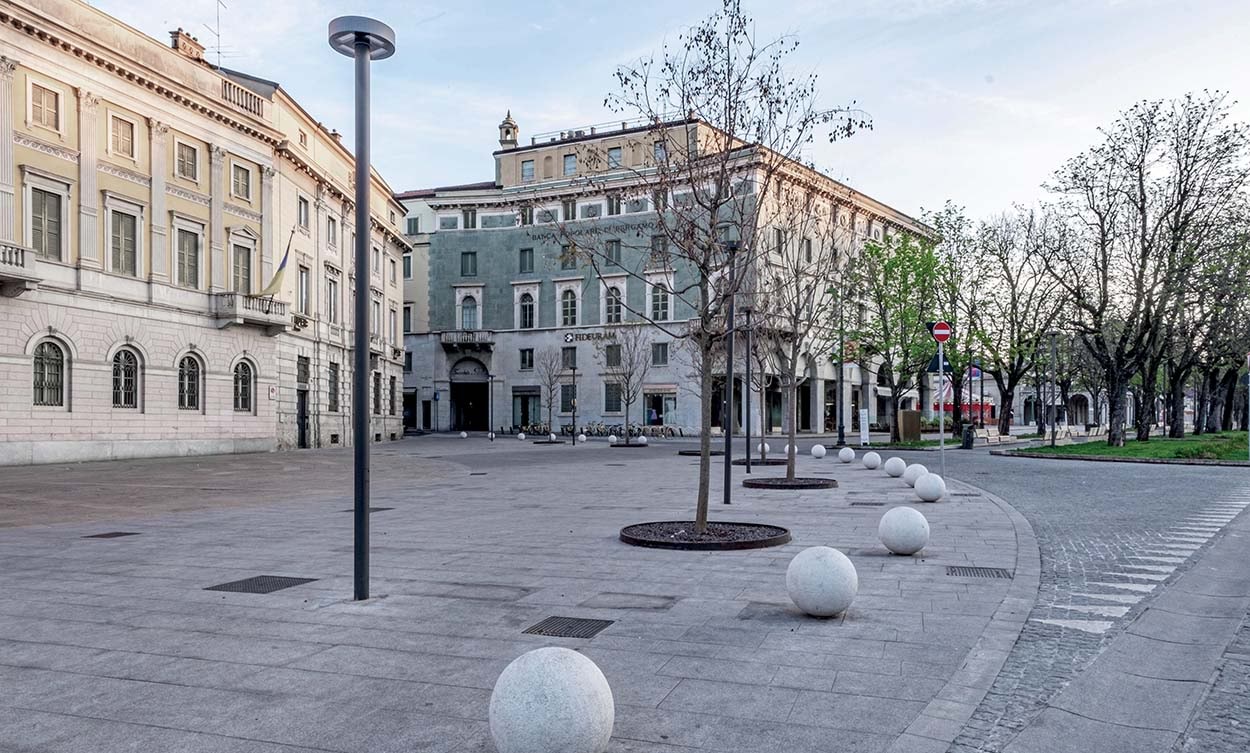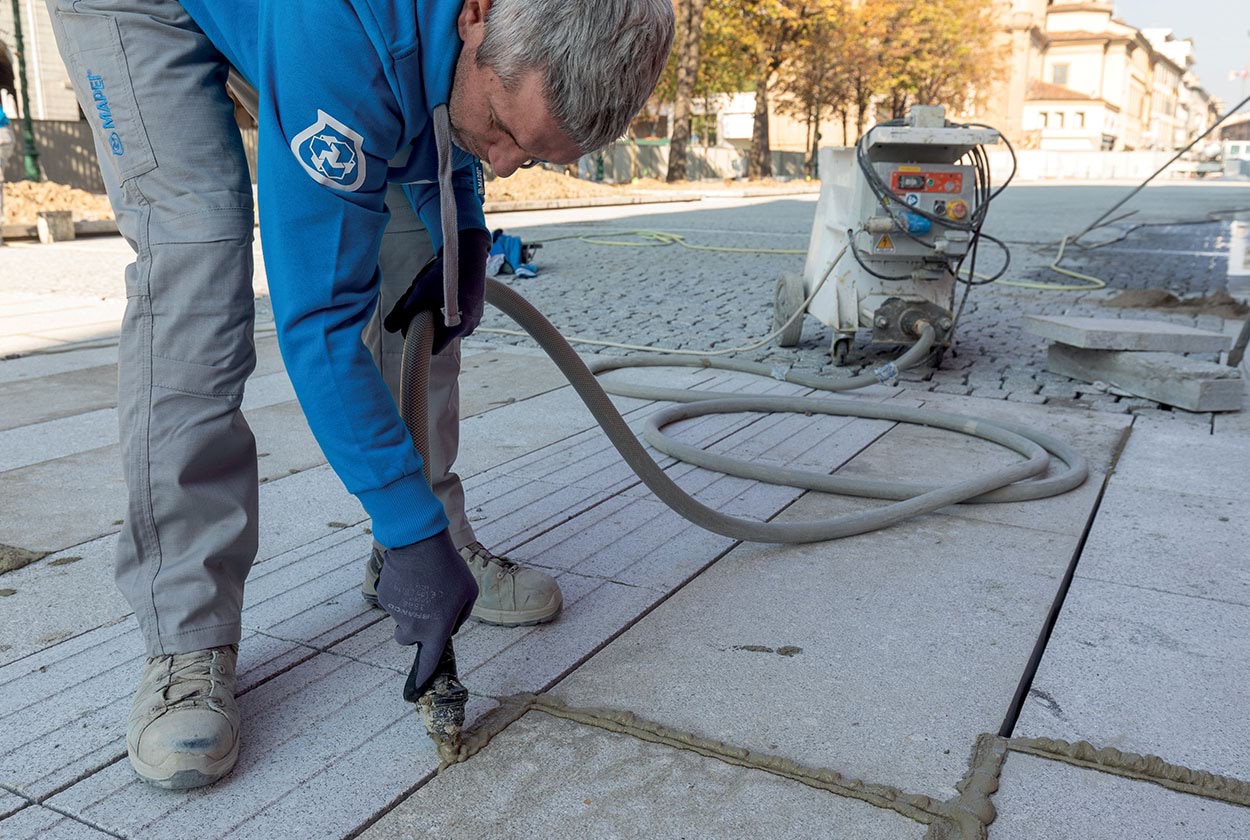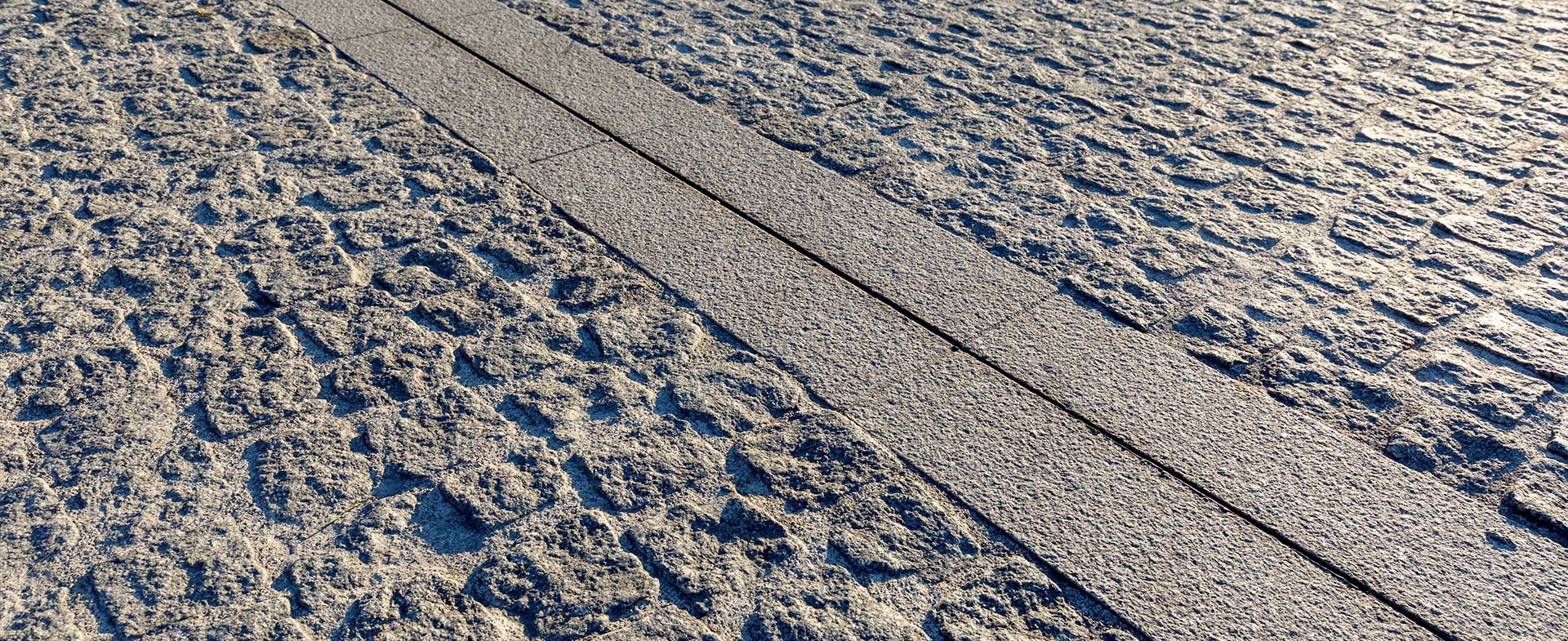
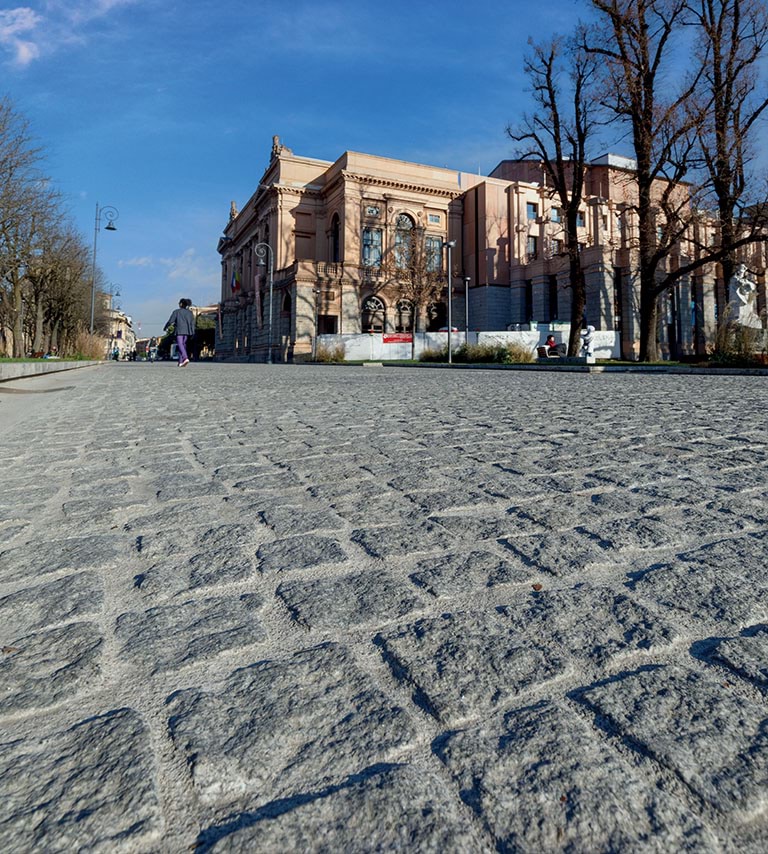
Projects
/
8/2/2023
Refurbishing the Centro Piacentiniano one century on
A team of six professionals renovated the heart of modern Bergamo
The intervention, dedicated to the architecture of the shoreline, in addition to expanding the equipment to the area with extra benches, streetlights and trees, focused on the paving.
In the 1920’s the intervention by architect Marcello Piacentini started to take shape, which gave a new look to the most modern area of Bergamo, the contemporary district close to rail networks and free to develop and extend. The subject is an architectural complex winding its way between Piazza Vittorio Veneto, Piazza Dante and “Sentierone” Avenue up to Piazza della Libertà, on its way taking in the Donizetti Theatre. At a distance of almost a century since then, this area was the subject of extensive urban refurbishment work. The intervention was strategic for the future of the city and featured in the Bergamo and Brescia Capital of Culture 2023 dossier as one of the most important elements of connectivity and a general relaunch of the urban territory.
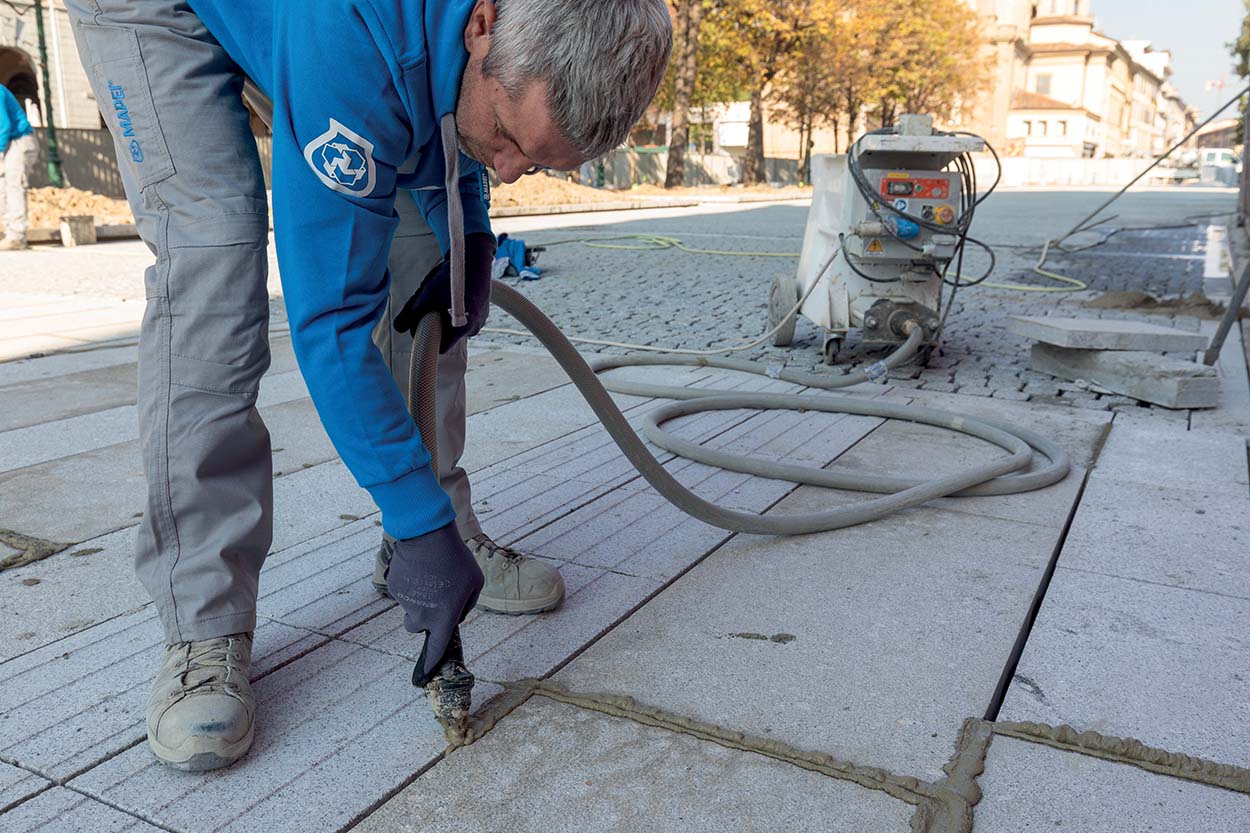
Application and cleaning of MAPESTONE PFS2 FLEX used to grout joints.
The project
The project was launched back in 2015 when the City Council was looking to remediate the emptying of the city centre, which had become less frequented by the city’s inhabitants and commercial activities and, as a result, a generally less safe place to be. The City Council launched a Europe-level competition for ideas on how to intervene respectfully on this area. The intervention was rather delicate: refurbish an area of 28,000 m2 by introducing pedestrianised zones while respecting its green spaces and monuments, often the subject of numerous cultural, environmental and archaeological constraints, and, a place for which the citizens of Bergamo have such a strong sense of belonging. The winning project was the one presented by a collective of six architects, engineers and designers from Bergamo specialised in the design of open spaces: Luigino Pirola, Mariola Peretti, Simone Zenoni, Gianluca Gelmini, Carlo Peretti and Elena Franchioni. The name of the collective is Flânerie, a French term that describes the activities of the flâneurs, people who take a pleasant stroll along city streets without hurrying, enjoying the feelings that arise from simply observing their surroundings. And the local Council intended to give this part of the city back to flâneurs and walkers. The project concentrated on the architecture along the reference line (the average elevation is 30 to 50 cm) and, apart from enhancing the street features in the area by adding 100 benches, 160 lampposts and 13 trees, focused particular attention on the paving.

Application and cleaning of MAPESTONE PFS2 FLEX used to grout joints.
Old and new paving
The existing paving in the entire Centro Piacentiniano area was carefully mapped out, identifying the more historic parts that needed to be safeguarded and fully conserved, and the more recent parts, characterised by their generally good state of conservation and adequate functionality and aesthetics, which included the stellato granite paving installed along Sentierone Avenue in 2006. More than 15,000 m2 of asphalt paving, on the other hand, was replaced with more “noble” paving consisting of stone elements, which were integrated with tactile paving to aid visually impaired pedestrians. In order not to interfere with the historic context, the tactile itineraries were created using textured granite slabs with a similar finish to that of the rest of the paving. The paving work was divided into 3 lots and commenced in the second half of 2021. The first lot concentrated on Piazza Dante, which was completely pedestrianised and a new layout was created for the green area. Lot 2 involved the side of the Donizetti Theatre where the cultural and events hub is located, while lot 3 covered the City Council offices. The refurbishment project also covered the area joining lots 2 and 3, consisting of the link road for the intense traffic to and from the Upper City, one of the iconic areas of Bergamo. This is a link that reinforces the functional and perceptive bond between the two souls of the city: the more ancient Upper Bergamo and Lower Bergamo, the modern part of the city. Another cardinal theme of the competition was sustainability and the specifications for the project included CAM (Minimum Environmental Criteria established by the Italian Ministry of the Environment and Protection of Land and Sea to ensure the use of environmentally sustainable solutions and products for public buildings) covering the buildings part, lighting systems, public green areas and street furniture, as well as CAM for site management practices, considered a fundamental requirement in order to reduce to a minimum the impact the execution phase would have in the residential areas of the ancient city.

Samples of the mixes used to install (MAPESTONE TFB 60) and grout (MAPESTONE PFS2 FLEX) the stone paving were tested to make sure they were prepared correctly and complied with the specified performance properties.
Mapei solutions for the paving
To meet durability and sustainability requirements, the packages for the slab and block paving were designed according to the types of stresses and loads they would be subjected to, separating them into three groups: occasional traffic (class P7 according to Italian standard UNI 11714-1), limited traffic (class P8) and intense and general traffic (class P9). The project specified the use of MAPESTONE SYSTEM to install the paving, according to the type of traffic. Specifically formulated for making cost-effective, durable, urban stone paving with lower maintenance requirements, including paving exposed to high levels of traffic, MAPESTONE SYSTEM includes a range of products in exposure class XF4 that comply with the prescriptions and requirements of Italian standard UNI 11714-1:2018 and European standard EN 206-1 to guarantee the durability of paving. Thanks to its resistance to freeze-thaw cycles, de-icing salts and rain, paving made using MAPESTONE SYSTEM is a monolithic system that doesn’t break apart and remains unaltered over time, thereby eliminating the need for maintenance work for a number of years. To install the 8/10 granite cubes and 6 cm thick slabs in class P7, an installation bed with an average thickness of 5 to 7 cm was created using MAPESTONE TFB CUBE pre-blended mortar, while MAPESTONE TFB 60 pre-blended mortar was used for the stone slabs in classes P8 and P9. In both cases, the MAPESTONE TFB CUBE and MAPESTONE TFB 60 installation mortars were supplied in bulk loads stored in silos for logistics and site sustainability purposes, as per project specifications. The joints (average width 10 mm) were grouted with MAPESTONE PFS2 FLEX pre-blended mortar with a high modulus of elasticity and pull-off strength three times higher than traditional mortar, two properties that make it far more effective in cushioning stresses created by the passage of vehicles and by thermal expansion. These properties help increase the resistance of joints when in service, which play a key role in guaranteeing the durability of paving. The joints were sealed with MAPEFLEX E-PU 30 NS two-component, thixotropic epoxy-polyurethane sealant with high resistance to chemicals, high mechanical properties and high modulus of elasticity. A special approach was adopted for the important road link, used on a daily basis for traffic to and from the city centre, including public transport and heavy-goods vehicles. 14 cm thick granite slabs were used for the continuous slabbed paving in Sentierone Avenue, the historic main thoroughfare of the city, and were installed with MAPESTONE SYSTEM comprising MAPESTONE TFB 60 and MAPESTONE PFS2 FLEX. For the block-paved part a different technical solution was adopted because the area continues along from the asphalt road surface and is in correspondence with the crossroads between both directions of the Centro Piacentiniano, which means it is subjected to far more stresses from the passage of vehicles. The 14 cm granite cubes, therefore, were installed on a loose bed of crushed porphyry and, because of its thickness, the joints were double-grouted with MAPESTONE JOINT solvent-free polyurethane resin for elastic and pervious paving. Work on the second lot started in February, 2021 and on the third lot in February, 2022 and was completed at the end of February, 2023, a faithful recreation of the original project and perfectly in time for the launch of the Bergamo and Brescia Capital of Culture 2023 festivities. With just a few days to go before the inauguration, the new Centro Piacentiniano invites everybody, inhabitants and tourists, to take part in a wonderful stroll and prove that the objective of the City Council and the proj-ect to bring inhabitants back and enjoy the city centre has been achieved.

The completed paving made up of stone slabs and cobblestones and the expansion joint.
Bergamo-Brescia, Italian Capital of Culture
The Italian Capital of Culture project was set up in 2014 after being proposed by the Italian Minister of Culture and Tourism. The aim is to promote projects and enterprises designed to enhance Italy's cultural heritage to stimulate the growth of tourism and related investment. The title of Italian Capital of Culture is awarded annually after candidate bids are assessed by a panel of seven independent experts. Thanks partly to a total of one million euros up for grabs, the winning city can showcase its most distinctive landmarks for a period of one year, as well as any other factors behind its cultural development seen a driving force for the growth of the entire community. 2023 is the year of Bergamo and Brescia, which were named the Italian Capital of Culture as part of a project which, on one hand, aims to make some sense of the pandemic that severely hit these cities and, on the other, will catalyse all the energy in this territory to boost innovation and its capacity to regenerate itself.






